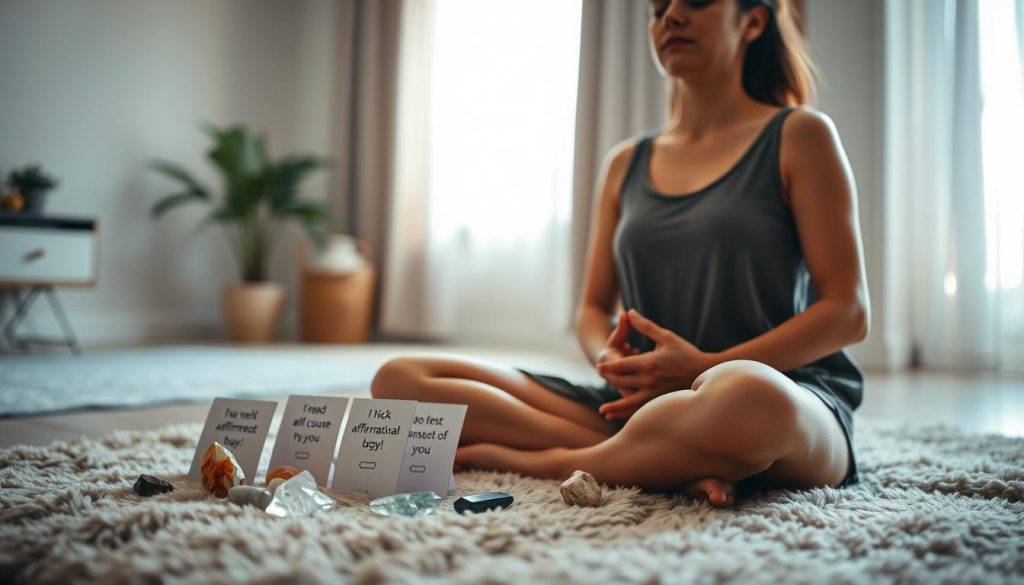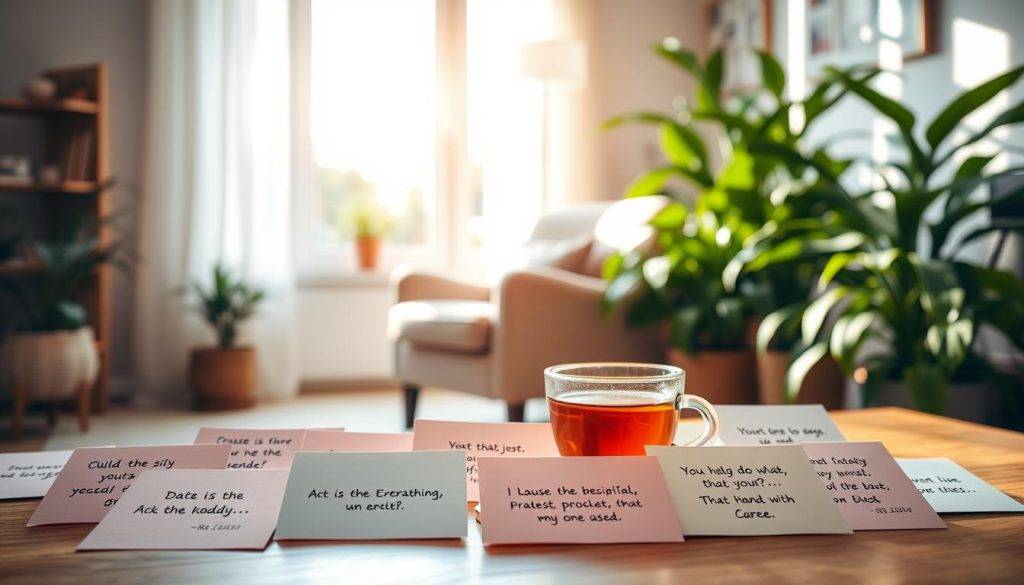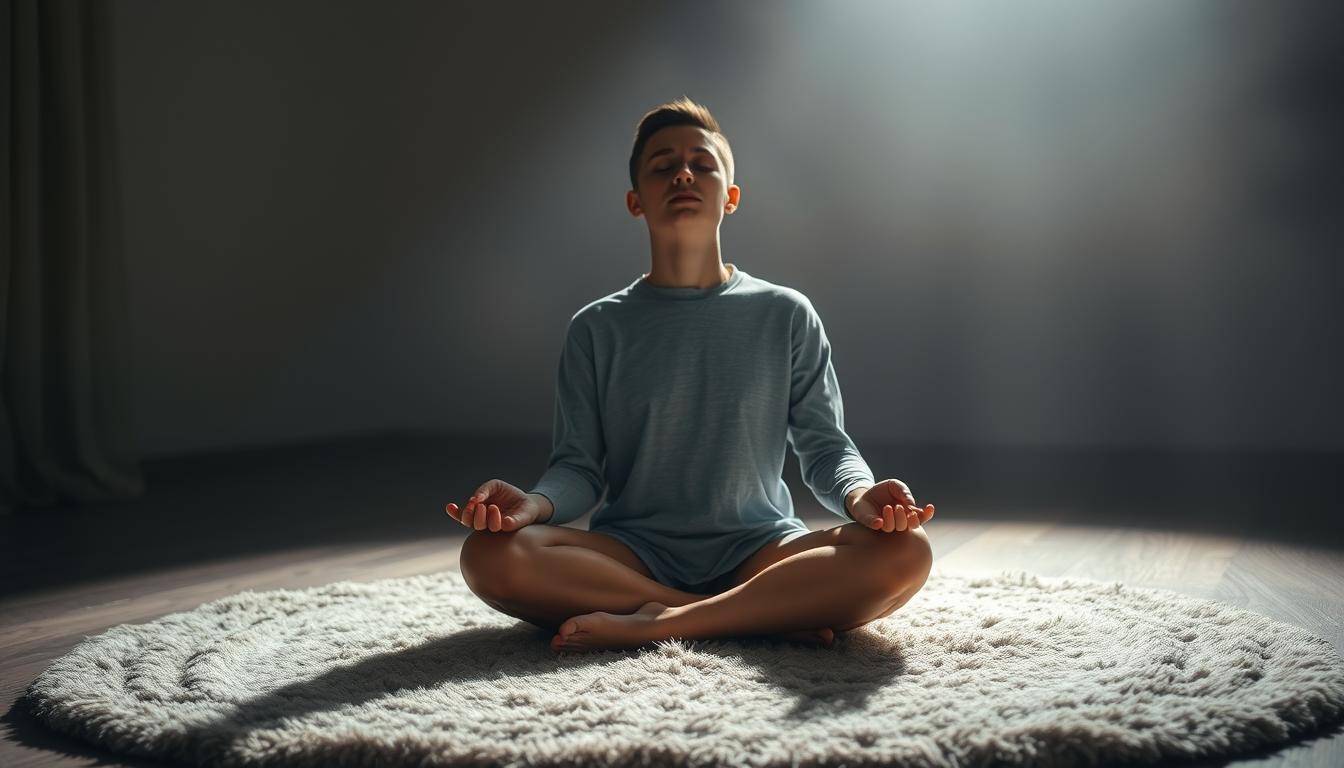“Peace comes from within. Do not seek it without.” — Buddha. This idea frames a simple promise: a short, focused practice can change an evening and a life.
After a long day—coming home from work or juggling kids and chores—20–30 minutes of focused self-practice can shift the nervous system toward calm. A brief routine helps the brain and body relax, steadies breathing, and quiets a busy mind.
This guide shows how hypnosis pairs with affirmations to deliver suggestions to the unconscious mind in a safe, controlled way. The practice keeps people fully aware and in control while making the mind more receptive to positive change.
Try a golden-light visualization moving through tense spots, paired with tailored affirmations spoken in your own voice. You can then choose to drift to sleep or return awake, alert, and calm—ready for a restful night or a peaceful remainder of the day.
Key Takeaways
- Twenty to thirty minutes after a busy day can trigger quick, noticeable calm.
- Hypnosis + Affirmations work together to influence the unconscious safely.
- Simple visualizations—like a golden light—help the brain downshift from stress.
- Recording your own voice strengthens resonance and follow-through.
- The routine ends with a choice: sleep or return awake and calm.
Why Hypnosis + Affirmations Work Right Now for Lasting Stress Freedom
A short, focused practice often delivers immediate relief and makes the brain more receptive to calm, helpful patterns.
Science shows that inward attention and reduced external distraction let the nervous system downshift. With less noise, the brain processes suggestions with more signal than static. This boosts the power of positive language used in practice.
What people notice after a 20–30 minute session: slower thought speed, softer jaw and shoulders, steady breathing, and a grounded presence that often lasts into the evening.

The relaxation loop and practical expectations
- Deepening breath relaxes muscles; the body signals safety to the brain, which eases mental tension in real time.
- Using present-tense wording matters—statements framed as current truths create a concrete target for behavior and feeling.
- Early sessions may include wandering thoughts; gentle redirection to breath or a visual cue restores focus without strain.
- Consistency beats intensity: brief regular practice builds a fast pathway back to calm when you need it most.
| Session Length | Typical Feelings | Practical Benefit |
|---|---|---|
| 10–15 minutes | Quieter mind, softer shoulders | Quick reset during a busy day or lunch break |
| 20–30 minutes | Slower thoughts, grounded presence | Transforms an evening after work into a calm night |
| Daily short practice | Faster shift from tension to ease | Builds lasting habit and resilience over times |
Recording your own voice increases relevance and follow-through. Try layering a simple phrase or two—spoken as if true—and notice how the brain accepts them more readily when the body is already calm.
Understanding Self-Hypnosis: Setting the Stage for Positive Affirmations
Start with a few steady breaths and a clear intention; this signals the brain to lower its guard. In this calm window, the unconscious mind becomes more open to short, direct input.
What self-hypnosis is: a deliberate shift into relaxed, focused attention that helps the unconscious register supportive affirmations. While fully awake and aware, a person can deliver simple suggestions that the mind accepts more readily.

How cues guide attention
Structured cues—breath, posture, and a single soothing image—quiet surface chatter. A golden, soft light moving through the body prepares both brain and heart to receive helpful lines of thought.
Staying in control
You remain alert and free to end the practice anytime. Comfort, warmth, and steady breathing signal safety; that feeling of safety deepens receptivity and supports lasting change over time.
- Pre-frame: state your intention and desired outcome before you begin.
- Repeat: concise phrases build stronger associations with practice.
- Adapt: sit or lie down, eyes open or closed—choose what feels right.
| Element | Purpose | Practical Tip |
|---|---|---|
| Breath | Calms nervous system | Slow inhales and longer exhales for 1–2 minutes |
| Posture | Signals readiness | Support back and relax shoulders to reduce tension |
| Single image | Focuses attention | Visualize warm, golden light moving through tense spots |
| Brief intention | Primes the mind | State a clear, present-tense goal before you begin |
Step-by-Step: A Present-Moment Self-Hypnosis Routine with Affirmations
Choose a quiet evening slot and treat the next 20–30 minutes as deliberate time to reset your body and brain. This brief routine gives structure so a busy mind can soften and settle.

Prepare your space and time
Pick a consistent moment in the day—early evening often works best. Silence phones, dim lights, and tell yourself this is a short, protected session.
Enter relaxation
Set posture: sit or lie comfortably and relax jaw and shoulders. Breathe slowly, extend the exhale, and let the mind rest on one gentle anchor.
Visualize the golden, protective light
See a warm, golden light surround you and then enter, moving into tight spots. Guide it down the neck, across the chest, into the belly and lower back.
Layer in positive affirmations
Affirmations are added now—short, present-tense lines spoken slowly. State them as if they are true in this moment.
- Prepare setting and commit the time.
- Set posture and soften focus.
- Move the protective light through tension areas.
- Add one or two concise affirmations to match your intention.
- Maintain agency: pause or change pace whenever you choose.
Example: as the light fills your chest, say quietly, “Joy and calmness are taking over.”
Close with choice: drift into sleep if it’s bedtime, or count up and return awake, alert, happy, and in full control to continue work or evening plans.
Building Effective Positive Affirmations People Actually Use
Crafting brief, present-tense lines that feel true in the body makes them far easier to use during real-life moments.
Guidelines: Keep statements present, specific, emotionally resonant, and short. Use language that creates a small physical change — softer shoulders or longer exhales — so the mind links words to sensation.

Practical steps
- Use present tense: speak as if it is already happening.
- Be specific: tie lines to real things you do, like ending a meeting or stepping into the car.
- evoke feeling: choose words that warm the chest or ease the breath.
- Test one phrase: try it at different times and note which feels most natural.
Examples you can adapt
“Joy and calmness are taking over.”
“My mistake is becoming a learning opportunity.”
“I let go of any anxiety or fear and welcome peace of mind.”
“As I look back on today I’m grateful to have lived this day.”
Vary tone by times of day: energetic lines for mornings, steady phrases for midday, and deeply soothing words for evening. Personalize until the phrasing sounds like your voice — that is the true test of usefulness.
| Challenge | Short phrase | When to use |
|---|---|---|
| Work stress | “I respond with calm clarity.” | Before meetings or calls |
| Self-doubt | “My mistake is a lesson.” | After feedback or errors |
| Evening tension | “I welcome peace of mind.” | Wind-down and bedtime |
Tools, Examples, and Troubleshooting for Hypnosis + Affirmations
Practical recording, short routines, and clear tracking transform occasional practice into lasting habit. Use simple tools so the practice fits real life and becomes reliable.

Recording in your own voice
ThinkUp is a useful example: record short, present-tense lines in your natural tone and play them during a session. Practitioner Goulie Scheer reports consistent positive changes when people use their own recordings.
When the mind won’t settle
Shorten the routine to five minutes and follow the first two steps: steady breath and the golden-light scan. If rumination stays strong, do a body-led scan and add one gentle suggestion near the end.
How often to practice and how to track progress
Aim for 20–30 minutes most days, ideally before or after work. Keep a simple log: time of day, which phrases you used, and how you felt afterward. Note the small things that move the needle.
- Make themed playlists (calm, focus, confidence) so you can pick what you would like quickly.
- Keep volume low and pace slow—leave space after each phrase so the brain can register it.
- When motivation dips, pair practice with a small reward like tea or a short walk.
“Even brief, consistent practice builds a reliable pathway to calm.” — Goulie Scheer
Conclusion
One short routine, practiced at predictable times, creates a reliable path back to calm.
In summary, a focused self-practice that pairs gentle Hypnosis with present-tense Affirmations soothes the body and steadies the mind. Ten to thirty minutes is enough to change the quality of an evening.
You remain in control: choose the pace, the words, and whether you end in sleep or return alert and ready. Keep what works, adjust what doesn’t, and repeat the few things you would like to feel more often.
People who practice report easier transitions from stress to rest, better sleep onset, and stronger responses to daily challenges. Start today—pick one time, one visualization, and one phrase, then notice the change.
FAQ
What is self-hypnosis and how do suggestions reach the unconscious mind?
Self-hypnosis is a guided, relaxed state in which focused suggestions can bypass surface thinking and access deeper patterns. By using calm breathing, soft focus, and repetition, a person lowers stress-related arousal and gives the brain clear, present-tense cues that the unconscious can adopt as new habits.
How do positive statements work together with a relaxed state for stress relief?
When the body is relaxed, the brain is more receptive to new ideas. Short, emotionally clear statements delivered in that state are more likely to reshape automatic responses—reducing reactivity, improving mood, and promoting restful sleep or calm alertness during the day.
When is the best time of day to practice a short routine?
Choose a consistent quiet window—often early morning or before bed—when interruptions are minimal. Ten to twenty minutes at a regular time helps establish neural patterns so the benefits carry into busy work periods and evening rest.
How often should someone practice to see measurable change?
Start with daily practice for at least two weeks to notice shifts in mood and automatic responses. Many people move to five sessions per week after habits form. Tracking simple measures—sleep quality, reactivity, or stress scores—helps identify what’s effective.
What if the mind won’t settle or intrusive thoughts appear?
Acknowledge thoughts without judgment, return focus to the breath or a neutral anchor, and shorten the session if needed. Gentle consistency matters more than length; even brief, calm repetitions rebuild control and reduce resistance over time.
Can people remain fully in control while using these techniques?
Yes. The approach supports relaxed awareness, not loss of control. People stay aware enough to end a session, move, or make decisions. The goal is increased self-regulation, not surrendering agency.
How should statements be written to be most effective?
Use present-tense, specific, short, and emotionally resonant language. Focus on what is desired—confidence, calm, restful sleep—phrased as if it’s already happening. Keep each statement vivid and believable to the person practicing.
Can someone record their own voice and use an app to play routines?
Recording a personal voice can boost effectiveness because it feels authentic and familiar. Apps like ThinkUp support custom recordings, repetition, and scheduling—making it easier to maintain a consistent practice.
What are simple example statements for common challenges?
For work stress: “I handle tasks calmly and clearly.” For sleep: “My body relaxes; I fall into deep, restoring sleep.” For confidence: “I trust my skills and speak with ease.” Tailor wording to feel true and immediately usable.
How long before affirmations and relaxation routines translate into daily life changes?
Many notice small improvements in days to weeks and stronger changes in one to three months with regular practice. Durability increases when routines are combined with supportive habits like healthier sleep, movement, and stress management.
How should progress be tracked to know what works?
Use simple, repeatable measures—sleep hours, perceived stress ratings, reaction to triggering events, or a short journaling habit. Weekly reviews reveal patterns and help refine statements, timing, and session length.
What adjustments help on days when energy or motivation is low?
Shorten the session to five minutes, use grounding breathwork, or play a familiar recorded routine. Gentle movement before practice—stretching or a brief walk—can reduce restlessness and make the mind more receptive.
Are there safety or contraindications to consider?
Most people benefit from these gentle techniques. Those with certain psychiatric conditions should consult a licensed clinician before starting intensive practices. If any practice increases distress, stop and seek professional guidance.
How do visualization and protective imagery enhance a session?
Imagining a warm, protective light or a calming scene adds sensory depth to statements and helps the nervous system shift from arousal to safety. Vivid imagery makes suggestions feel more real and supports emotional regulation.
Can these methods improve sleep and daytime focus at the same time?
Yes. Evening sessions that combine relaxation with sleep-focused statements improve sleep onset and quality, which in turn enhances daytime focus and resilience. Daytime practices strengthen composure during work and interactions.




























































